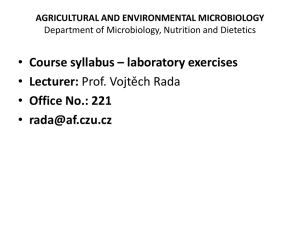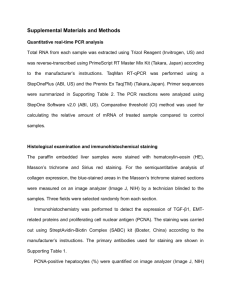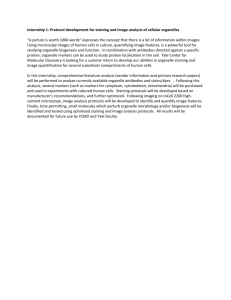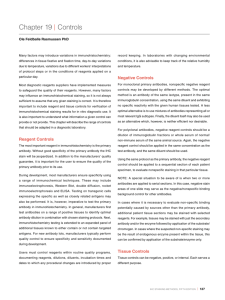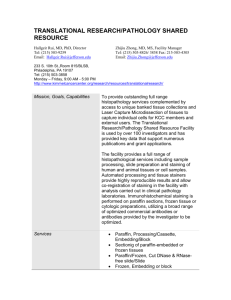IHC Guidebook - Controls - Chapter 14
advertisement
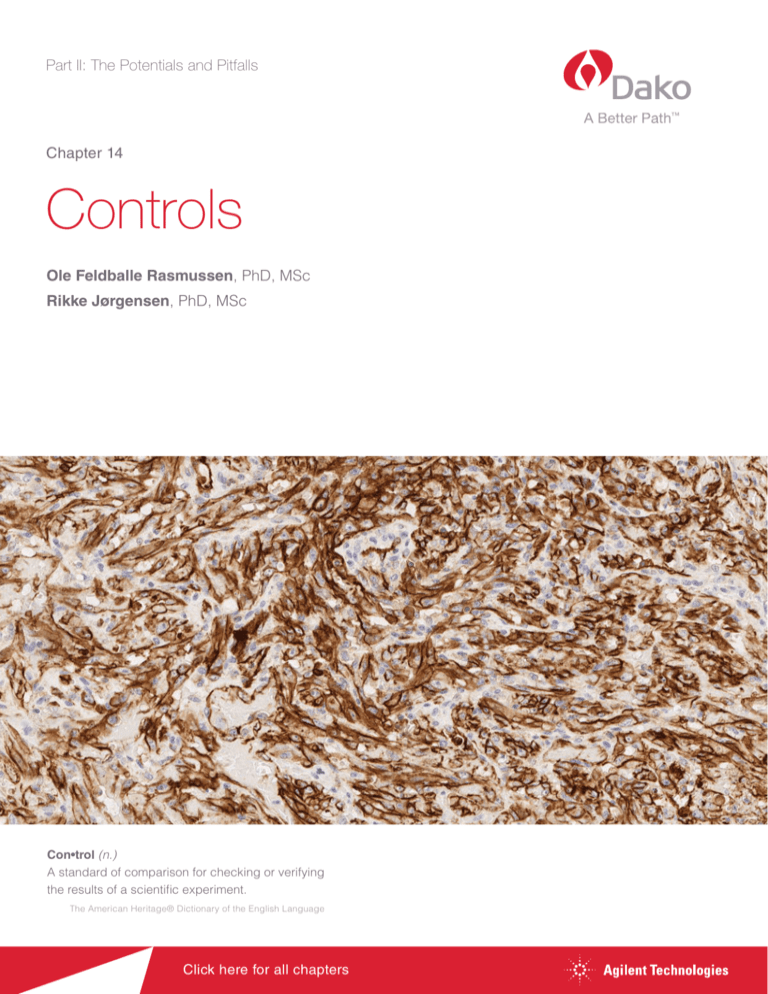
Part II: The Potentials and Pitfalls Chapter 14 Controls Ole Feldballe Rasmussen, PhD, MSc Rikke Jørgensen, PhD, MSc Con•trol (n.) A standard of comparison for checking or verifying the results of a scientific experiment. The American Heritage® Dictionary of the English Language Click here for all chapters Controls | Chapter 14 Chapter 14.1 Introduction nosis. The controls will show whether all reagents are in good order, and very importantly, they will also show if the staining system Many factors may introduce variations in immunohistochem- is working correctly and thus demonstrate potential day-to-day, istry including ischemic time, tissue fixative and fixation time, operator-to-operator and/or instrument-to-instrument variations. tissue processing, efficiency of epitope retrieval, selection of antibody/antibody clone, detection system, instrumentation – For many of the potential variations there are other measures in and not least interaction among the many different sources of place to safeguard; unfortunately, it is not always possible to ac- potential variation. count for extreme situations or equipment defects. Reagent expiry is one example. Reagent expiry dates are determined exper- All major suppliers of diagnostic systems to the pathology lab- imentally and extensively documented during development and oratories have implemented measures to safeguard the quality verification; testing includes extensive transportation scenarios, of their systems. These measures are implemented in develop- with changes in temperature and prolonged storage at increased ment and validation as well as during manufacturing and suppli- temperature. However, such investigation will never be able to er quality control. However, with the many potential factors that encompass all situations, e.g. that a package is lost for weeks may influence an immunohistochemical staining, it cannot be as- during shipment. Likewise, a defective refrigerator can impact re- sumed that any given IHC staining is correct. Consequently, it is agent quality. Sub-optimal reagent quality should be detected by important to include controls for verification of results for in vitro appropriate controls as part of the staining process. diagnostic use. It is also important to understand what information a given control can provide or not provide. Many countries have regulatory requirements for diagnostic methods, reagents, instruments and software, as well as vendor and laboratory responsibilities. For each laboratory it is important to understand and implement these requirements accordingly. For reference, a thorough description on Quality Management and Regulation in the US is given in (1). Vendor responsibilities In addition to country-specific requirements, the site of manufacture may also impact vendor responsibilities. In the EU, vendor responsibilities are determined by a specific IVD directive (98/79/EC). Basically, there are requirements for development and validation, as well as for manufacturing and quality control of IVD products. Key parameters that must be documented are included in the data/specification sheet or corresponding product specific documentation. For example, antibody vendors Figure 14.1 This chapter will describe the range of controls that should be used in a diagnostic laboratory. must ensure appropriate specificity using a range of immunochemical techniques, including immunoelectrophoresis, Western blot, double diffusion immunoassays and ELISA. Testing on transgenic cells expressing the specific, as well as closely Chapter 14.2 Purpose of Controls related, antigens may also be performed. It is, however, imperative also to include testing on tissue; both cancer tissue and In short, IHC staining controls are required for validation of stain- normal tissue, for high and low expression structures (see also ing results to document and/or ensure that each and every IHC Chapter 5). For primary antibodies, manufacturers typically first test is performed correctly and can be used to support the diag- test antibodies on a range of positive tissues to identify the op- 161 Chapter 14 | Controls timal antibody dilution in combination with the chosen staining For every immunohistochemistry staining run, at least one control protocol. Next, immunohistochemistry testing is extended to an should be included. This is straightforward when staining is car- expanded panel of additional tissues known to either contain, ried out in batch mode (see Chapter 9), however with continuous or not contain, targeted antigens. For new antibody lots, manu- slide loading, “a staining run” must be defined in a different way, facturers typically perform quality control to verify the specificity e.g. once per day, or once per x number of slides. The staining and sensitivity that were documented during development. run control may be expanded to at least one per antibody, and over the past years there has been an increasing use of control Laboratory responsibilities material on every slide (see below for further discussion). Laboratories performing IHC assays hold key responsibilities relating to controls: The saying, “if it isn’t documented, it didn’t happen”, directly ap- Laboratory validation of new antibodies, protocols and systems plies to the staining control mentioned. It is important that all pro- New reagent lot verification cedures and results – as well as procedural changes, are doc- Performance control for each run umented and proper record-keeping procedures are applied. In addition, it is advisable to implement a trend-tracking procedure to The exact responsibilities vary depending on the country and capture small changes over time, e.g. running a standard at reg- accreditation program. If the laboratory is enrolled in the US ular intervals. Many labs track the relative percentages of HER2 CAP’s (College of American Pathologists) laboratory accred- scores (0, 1+, 2+, 3+) to use as a indirect measure of assay per- itation program, the laboratory must comply with a specific formance over time. Changes in the relative percentage of HER2 checklist (2). Here it is specified that “The performance char- scores may warrant further investigation of the cause. If results acteristics of each assay in the immunohistochemistry labo- may be influenced by changing environmental conditions, it is also ratory must be appropriately validated before being placed advisable to keep track of the relative humidity and temperature. into clinical use”. The goal is to verify vendor specifications and the optimal staining protocol, as part of validating overall clinical performance. It is important to test a panel of positive and negative tissues to determine assay sensitivity and spec- Chapter 14.3 Categories of Controls and Control Material ificity. With respect to the number of tissues to be included for validation of an antibody, 10 positive and 10 negative tissues The terminology for the various control types are in some parts are suggested for well-characterized antibodies with a limited of the literature not clearly defined. This chapter uses the ter- number of targets/applications. A recent study investigated minology emphasized by Torlakovic (4). the use of immunohistochemistry validation procedures and 162 practices for non-predictive assays (3). The study was based Control material can be categorized in different ways: on 727 responders to a questionnaire composed of 32 items. Reagent controls Key results were that 68% of the laboratories had written vali- – Positive reagent control is the actual reagent; e.g. the dation procedures, and 86 % had validated the most recently primary antibody when tested on control material. Testing introduced antibody. With respect to the number of different is done during development and product validation to en- tissues included in the validation, 75% used 21 or fewer cases sure reagent specificity and sensitivity. for the validation. primary antibody used to assess potential specificity New reagent lot verification is also addressed in the CAP An- issues/false positive staining reaction atomic Pathology Checklist, where it is stated that “the perfor- Tissue controls mance of new lots of antibody and detection system reagents – Positive tissue control is tissue with the specific antigen – Negative reagent control is a reagent substitute for the is compared with old lots before or concurrently with being at known, relevant and stable level. Purpose is to docu- placed into service”. ment correct staining. Controls | Chapter 14 – Negative tissue control is tissue without the specific an- impractical to devise and run controls for every combination tigen present – or not present in specific regions. Purpose of pre-analytical and analytical factors, data on controls in di- is to document specificity of the staining. agnostic immunohistochemistry, as well as in research, must – Tissue blocks/tissue microarrays, consisting of a few to be included for valid and reproducible test results. Correctly several different tissues that may serve as control mate- used controls can reveal if the staining protocols were run rial for a range of antibodies (see Chapter 12) correctly, and help determine day-to-day and operator-to-op- Internal tissue controls erator variations. – The presence of the target antigen (protein) within normal elements of the tissue under investigation is an internal positive control Tissue process control – Constitutively expressed proteins generally expressed in all tissues at the same level. Such a protein may serve as control for not only the staining process but also for the pre-analytical steps. Cell line controls – Control material based on cultured cells with specific antigenic characteristics. This type of control typically is made for very specific purposes, in particular predic- tive assays. Chapter 14.4 Use of Controls in Daily Routine Testing The many sources of variations, as well as the potentially critical consequences thereof, call for standardization, assay validation and use of controls. Although awareness of the com- A B C Figure 14.2 On-slide positive tissue controls, where specific controls are placed on the same slide as the test specimen are strongly preferred. A) Illustration of the principle of multi-core blocks. Tissue controls are the cores in red, yellow, gray and green. Patient sample is placed below B) Example of on-slide tissue controls. C) Example of cell line controls. plexity of immunohistochemical assays and the inevitable variation is increasing, a meta-analysis of 100 peer-reviewed papers on immunohistochemistry revealed that only 13% of the Reagent controls articles described positive and negative controls run on identi- Negative reagent control for polymer-based detection systems cally prepared samples. More than half of the articles either did Since the start of IHC, it has been good practice to include not mention controls, or did not run controls as separate speci- a negative reagent control to check for specificity of the rea- mens (5). The papers included in the meta-analysis have both gents. In recent years, there has been a significant improve- diagnostic and research focus, underlining the importance of ment in both sensitivity and specificity of detection systems. A paying proper attention to inclusion of controls in both types of key element has been development of polymer-based, biotin- IHC applications. free visualization systems, which has reduced the need for negative reagent controls for such detection systems. In fact, This section will elaborate on the different types of controls recently, the US CAP organization changed its recommenda- used in IHC and their applications in the diagnostic labo- tion for US laboratories, now stating that for polymer-based (bi- ratory. Controls are a necessity for proper interpretation of otin-free) systems, negative reagent controls may be omitted staining, and omitting them will entail a risk. Although it is at the discretion of the laboratory director (2). 163 Chapter 14 | Controls Currently, most antibody specification sheets from major vendors NOTE: A special situation worthy of note is when a panel of two include suggestions for appropriate negative reagent controls, or more antibodies (of the same species) is applied to serial sec- with no reference to choice of detection system; and as stated tions, using the same detection system. In this instance, negative- in the US CAP recommendation, the negative reagent control ly stained areas of one slide may serve as the negative/non-spe- should be omitted only when given appropriate consideration. cific binding background control for other antibodies in the panel. Thus, laboratories must still pay attention to potential artifacts In cases where it is necessary to evaluate non-specific bind- or special cases, for example occurrence of non-specific DAB ing, potentially caused by sources other than the primary an- precipitates when performing staining of small bacteria or vi- tibody, additional patient tissue sections may be stained with ruses. DAB precipitates may resemble small stained elements, selected reagents. For example, tissues may be stained with which could complicate interpretation of the staining result. A just the secondary antibody and/or the enzyme, followed by negative control would help determine if the staining seen in application of the substrate/chromogen. In cases where the the patient sample is a false positive result. suspected non-specific staining may be the result of endogenous enzyme present within the tissue, this possibility can be Negative reagent control for biotin-based detection systems confirmed by application of the substrate/enzyme only. For tests using biotin-based detedtion systems, a negative reagent control test should still be included in all runs, due to Tissue Controls the inherent possibility of endogenous reactivity. This test has As noted in above, both positive and negative tissue controls to be done on a separate section of patient tissue, using the provide important information and must be included in daily same staining protocol with same target retrieval and detection routine regardless of type of detection system used. Typical- system, except that the primary antibody is replaced by the ly, the tissues being used for controls are carefully selected negative reagent control. normal or cancer tissues previously analyzed in the laboratory. However, in some cases the actual patient tissue being For monoclonal mouse primary antibodies, the negative re- tested can be used as tissue control. For all tissue controls, agent controls may be developed by different methods. The if the staining does not perform as expected, results from the optimal method is an antibody of the same isotype, present respective test specimen should be considered invalid. in the same immunoglobulin concentration, using the same diluent and exhibiting no specific reactivity with the given Positive tissue control human tissues tested. A less optimal alternative is to use mix- The positive tissue control must contain the target antigen at rel- tures of antibodies representing all or most relevant IgG sub- evant, known and stable expression level. It serves to document types. Finally, the diluent itself may also be used as an alterna- that proper staining has been performed and confirms that the tive which, however, is neither efficient nor desirable. target retrieval procedure has been carried out correctly. Thus, a positive tissue control assesses correct staining protocol perfor- For polyclonal antibodies, negative reagent controls should be mance (temperature, time and correct application of reagents). a dilution of immunoglobulin fractions, or whole normal (non-immune) serum of the same animal source. Again, the negative As positive tissue controls are indicative of properly prepared reagent control should be applied in the same concentration as tissue, they should be as accurate as possible in the same the test antibody, and the same diluent should be used. manner as the patient samples. Optimally, autopsy/biopsy/surgical specimens should be fixed, processed and embedded 164 Using the same protocol as the primary antibody, the nega- as soon as possible for best preservation of antigens. Gener- tive reagent control should be applied to a sequential section ally, autopsy tissue is least preferred because of inevitable de- of each patient specimen, to evaluate nonspecific staining in lays before fixation (cold ischemia, with degradation of some that particular tissue. antigens, see also Chapter 2). Controls | Chapter 14 Furthermore, the positive controls should be properly docu- separate slide - as a batch control or daily control, or they may mented, including sectioning date and storage conditions for be included on the same slides as the test specimens. Using the control material. Special attention should be given to the sta- batch run controls, with the control section on a separate slide, bility of the specific antigen(s) to be controlled, as antigen deg- the control slide will be indicative that the staining process has radation occurs in cut, unstained slides, at different rates de- run correctly. However, batch controls will not be able to iden- pendent on the antigen (6). A different challenge may be access tify a missing reagent (false negative), wrong antibody (false to optimal tissue control material; in particular in cases where positive) or inappropriate protocol (false negative or false posi- normal tissue may not be used, e.g. for certain viral infections. tive) on any other slides run on the instrument in that batch oth- Finally, the use of patient material for control tissue must comply er than on the control slide itself. Consequently, on-slide pos- with local or regional regulations. itive controls, where specific controls are placed on the same slide as the test specimen are strongly preferred (Figure 14.2). Ideally these controls should contain a spectrum of weak to strongly positive staining reaction. If such tissue is not avail- More and more laboratories are using TMA cores as on-slide able, at least a weakly positive tissue should be used, as this controls. It is possible to build a few basic multi-tissue control provides the best basis to evaluate whether a particular stain- blocks each containing a small number of control tissues to ing reaction is optimal (see also Chapter 4 and Chapter 5). cover most of the markers used in clinical diagnostics. NordiQC, an independent scientific organization arranging quality On-slide positive tissue controls schemes for pathology laboratories, has made a suggestion In the daily routine, positive tissue controls may be run on a for set of four multi-tissue control blocks each containing four Colon, HE Tongue, LE Case 3 A Case 2 B Case 1 Figure 14.3 Normal colon from three different cases stained with Anti-Actin, clone HHF35. Smooth muscle cells in vessel wall, muscle layers and lamina muscularis mucosa, defined as high expression (HE) structure, show comparable staining intensity in all three samples. B) Normal tongue from three different cases stained with Anti-Actin, clone HHF35. The myoepithelial cells of the mucous/salivary glands, defined as low expression (LE) structure, show comparable staining intensity in all three samples. 165 Chapter 14 | Controls different – and preferably normal – tissues that can be used when selecting the normal tissue that is optimal as control for most of the markers used in clinical diagnostics. For each tissue, by using a validated protocol that is able to identify block, the specific antibodies covered are specified, together variations in antigen expression. with the reaction pattern on each control tissue, as well as quality indicators for diagnostic use if available (7). As an example, Negative Tissue Control one of the multi-tissue control blocks contains appendix, tonsil, A negative tissue control is tissue that lacks the specific antigen pancreas and liver, and the reaction patterns are described for – or where the antigen is not present in specific regions. It serves approximately 100 different antibodies. to ascertain specificity of the staining. If using the ‘on-slide TMA method’, one of the cores should be negative, or contain struc- Dako has created an Atlas of Stains book that for each an- tures/cells that are expected to be negative for the antibody that tibody in the FLEX RTU (Ready-To-Use) series specifies rec- is being used. The negative tissue control must be included ommended control tissues with low expression (LE) and high to identify the correct specificity of the antibody; showing no expression (HE) quality indicator structures to use. In addi- staining of structures or cells that are known to lack the anti- tion,matching descriptions and images of the expected stain- gen. The negative tissue control also serves for identification ing patterns are included. of sub-optimal protocol (high background). Just as for positive controls, tissue used for negative controls should be prepared in Example of positive tissue controls the same manner as the patient sample. The shown example is for Anti-Actin, clone HHF35, where the defined HE and LE structures are present in different tissue Internal Tissue Controls types; in colon all smooth muscle cells in vessel wall, muscle Positive internal controls, also known as ‘built-in’ or intrinsic layers and lamina muscularis mucosa are defined as HE (Fig- controls, contain the target antigen within normal tissue ele- ure 14.3A), whereas LE is the myoepithelial cells of the mu- ments, in addition to the tissue elements to be evaluated. This cous/salivary glands in tongue (Figure 14.3B). circumstance appears ideal, as the tissue elements to be evaluated have been treated exactly as the positive control. However, the level of target in the internal positive control is not pre- where antigen expression varies too much to be defined as determined, and may or may not be as stable as the external stable. Using the same Anti-Actin as example, normal liver tissue control. Thus, when analyzing the slide, careful assess- tissue shows staining of perisinusoidal smooth muscle cells ment of the internal positive control is important. Obviously, if – but only in some samples (Figure 14.4). This variability em- the test slide only contains tumor tissue, an internal control is phasizes that all normal tissues may not, by default, be suita- not an option. One example of a positive internal tissue control ble as control tissue. Detailed analysis should be carried out is weak expression of the estrogen receptor in normal breast Liver However, evaluation of various normal tissues can show cases Figure 14.4 Normal liver from three different cases. The staining intensity of perisinusoidal smooth muscle cells varies from weak to negative, and is consequently a poor control tissue due to the variable antigen expression between tissue samples. 166 Controls | Chapter 14 ducts. Thus, if the section to be tested is selected to include of controls that makes tissue process control effective in daily normal benign duct structures, these cells will be an excellent routine exists. positive control. Another example is presence of S-100 protein in both melanoma and in normal tissue, such as peripheral nerves and dendritic reticulum cells (Figure 14.5). Internal Chapter 14.6 Cell Line Controls controls can of course also function as negative controls when cells known to lack the antigen in question are used. Several FDA-approved companion diagnostics contain cell line controls as part of the kit, or sold separately. These cell lines are specifically developed to monitor staining of the antigen of interest and should be included in all staining runs as an additional protocol control. Just as with tissue controls, cell line controls may be positive or negative. Positive cell line controls monitor staining performance by assessing target retrieval, blocking, antibody incubation and visualization. Negative cell line controls assess specificity and, depending on the characteristics of the chosen cell line, may also provide information on performance. It must be emphasized that because processing differs for these cell lines, they do not serve as control for pre-analytic variables; only internal controls do that. Figure 14.5 Normal appendix stained with Anti-S-100. The satellite cells and the Schwann cells of the peripheral nerves show a moderate to strong staining reaction. An ideal negative cell line control will contain an amount of target antigen that is sufficiently low to produce no staining if the procedure has been performed correctly. At the same Quantified, ‘built in’, or internal, proteins may potentially serve time, the amount may be sufficiently high to produce a weakly as calibrators for quantification in IHC (Quantifiable Internal positive stain if the run has been performed under conditions Reference Standard – see Chapter 1, and (9), in much the that produce an excessively strong staining. same way as housekeeping genes, such as actin, serve as internal reference controls for expression studies (8, 9). An ideal positive cell line control would contain a number of target antigens producing staining of medium intensity. This would allow the control to assess both stains that are too weak Chapter 14.5 Tissue Process Control and stains that are too strong. The controls described in section 14.4 all serve to document An example of the way in which cell line controls can be used is the staining process. However, the pre-analytic steps, in par- illustrated by Dako’s HercepTest™ kit, which contains three cell ticularly the ischemic time and fixation, can have significant line controls: 0 (negative), a 1+ (weak staining) and a 3+ (strong impact on the capability of the tissue to provide good stain- staining). All are placed on the same microscope slide. The scale ing. Unfortunately, it has not yet been possible to develop ef- used for HER2 scoring (0, 1+, 2+, 3+) is arbitrary, and does not ficient controls that are optimal for the pre-analytic process. It represent the proportional difference in target molecules per has been speculated to use constitutively expressed proteins cell. The control cell line with 3+ score has an estimated num- present in the test sample (8, 9). Battifora (8) suggested the ber of 1,400,000 to 2,390,000 receptors per cell, up to a 30-fold use of vimentin for this purpose. However, no broad system increase over the number of receptors expressed by the 1+ cell 167 Chapter 14 | Controls line (12, 13) (Table 14.2). It is important to note that the staining cific slides. In addition, should the reading of control or test slides intensity of the control slides should not be used to interpret the give any reason for concern, the staining process data are likely staining intensity in patient samples by comparison. The cell lines to indicate which step may have introduced an error. Furthermore, are used only to indicate the validity of the staining run. the staining process data may be used to assess the stability of the instrument and indicate if one parameter may be drifting, so Table 14.2 The correlation between the number of HER2 receptors per cell and the resulting IHC score (9, 10). Cell line HER2 receptors IHC Score Staining Pattern MDA-231 21,600 0 No discernible membrane staining MDA-175 92,400 1+ Faint, discontinuous membrane staining SK-BR-3 1,400,0002,390,000 3+ Moderate/strong, complete membrane staining that service can be applied if necessary (see also Chapter 16). Chapter 14.8 External Quality Assurance Programs Most routine IHC staining results have no common quantitative measures. Instead, diagnostic IHC results are typically qualitative (yes/no answer) and are based on subjective interpretation by pathologists of varying experience (11). Quality control and assurance therefore remain crucial, and warrant high attention Negative Cell Line (MDA-231) 1+ Cell Line (MDA-175) 3+ Cell Line (SK-BR-3) by both manufacturers and the pathology laboratory. Internal quality control procedures in the individual laboratory are important for the reproducibility of the IHC performance, i.e. they will determine if the protocols, reagents and interpretations are working the same way, from day to day, and from individual to individual. However, internal quality control procedures will not necessarily identify if the staining is sub-optimal and if the IHC test Figure 14.6 Cell line controls for Dako HercepTest™. is sub-optimally calibrated an IHC result may be obtained, it just may not be correct (12). Consequently, it is important for laboratories to participate in proficiency testing through an external quality Chapter 14.7 Monitoring the Staining Process assessment (EQA) scheme. The EQA organization independently assess staining results from a range of laboratories, and identify New staining instruments from several manufacturers, exem- good staining quality as well as insufficient or poor staining, plus plified by the Dako Omnis and Autostainer Link 48, collect in- inappropriate protocols and possible interpretation problems. formation concerning a range of the key staining parameters; EQA schemes assess staining results by sending out tissue sam- either on a batch, slide rack, or single slide basis. The type of ples to be stained using the laboratory’s routine IHC staining pro- information collected may include onboard reagent tempera- cedures. Laboratories then return their results, and in some cases ture and time, to monitor reagent stability, target retrieval time examples of the stained slides, which are compared with all other and temperature. The data include temperature ramp-up and participating laboratories and summarized in a final report. ramp-down time, staining incubation time, and temperature at each individual step, as well as reagent use. Selected EQA schemes Canadian Immunohistochemistry Quality Control (Canada) 168 Today, monitoring of the staining process cannot replace the con- trols discussed above; however, it can provide information prior College of American Pathologists (CAP) (United States) – www.ciqc.ca to inspection of control slides that might indicate invalidity of the staining run, or indicate that special attention must be paid to spe- NordiQC (Based in Denmark) – www.nordiqc.org – www.cap.org Controls | Chapter 14 UK NEQAS (United Kingdom) – www.ukneqas.org.uk ries for the burden of both identifying proper tissue and internal manufacture of the control slides. However, such systems serve Similar programs are introduced in Australia, Austria, Germa- to validate only the analytic phase of IHC, and do not serve to ny, and other countries or regions around the world. control for pre-analytic error such as internal reference controls – if developed to routine use may do. A final note is that availability Chapter 14.9 Future Aspects of such systems is likely to speed up the adoption of on-slide controls – one critical factor, of course, being the price. To ensure diagnostic certainty, IHC quality control will remain a References very important and integrated part of the daily routine. Across 1. Prichard J. Quality management and regulation. In: Handbook of practical immunohistochemistry. New York: Springer Science; 2011. the world, there is an increasing requirement for laboratories to be accredited, and often accreditation includes a need for participation in proficiency testing. Thus the EQA schemes will see increased participation – and importance – becoming more widespread across the world. We also see that on-slide controls will be commonplace to provide a slide specific control, the challenge here being the workload and associated cost in 2. CAP. Anatomic pathology checklist. www.cap.org: College of American Pathologists; 2013. p. 34-8. 3. Hardy LB, Fitzgibbons PL, Goldsmith JD, Eisen RN, Beasley MB, Souers RJ, et al. Immunohistochemistry validation procedures and practices: A college of american pathologists survey of 727 laboratories. Arch Pathol Lab Med 2012;137:19-25. making and placing the on-slide controls. 4. Torlakovic EE. Quality control by tissue microarray in immunohisto chemistry. J Clin Pathol 2012 [Letter, 15 June 2012]. As discussed in Chapter 7, there is an increasing use of digital 5. Colasacco C, Mount S, Leiman G. Documentation of immunocyto chemistry controls in the cytopathologic literature: A meta-analysis of 100 journal articles. Diag Cytopathol 2011;39:245-50. whole slide imaging, and it is expected that this will become a widespread tool in the routine laboratory. In the context of this chapter, it is important to point out that both manufacturers and laboratories must comply with the requirements described in section 14.2, and ensure proper validation, both from the vendor side and at the laboratory, of the intended use of the system. Regulations for digital pathology are more extensively discussed in Chapter 7 (13). Moving further along, it is interesting to speculate to which extent digital imaging will be used in the process of automating the reading of control material, namely the tissue controls, cell block controls or protein spots. New technologies on the horizon will likely facilitate more efficient – and standardized – means of generating tissue control substitutes, one example being peptide IHC controls, where formalin-fixed peptide epitopes resembling the target protein are covalently attached to the glass microscope slides (14). Another possibility that may approach a more complete control of the IHC ‘total test’ (Chapter 1) is the ‘faux tissue’ or ‘Histoid’, which if fully developed has the potential also to control fixation variables, if not cold ischemia time (18, 19). When the performance of such systems has been documented to be comparable to tissue controls, they could be an effective tool relieving the laborato- 6. Xie R, Chung J-Y, Ylaya K, Williams RL, Guerrero N, Nakatsuka N, et al. Factors influencing the degradation of archival formalin fixed paraffin-embedded tissue sections. J Histochem & Cytochem 2011;59:356-65. 7. NordiQC. Recommended control tissue - multitissue control block. www.nordiqc.org/Techniques/Recommended_control_tissue.htm2005. 8. Battifora H. Assessment of antigen damage in immunohistochemistry. The vimentin internal control. Am J Clin Pathol. 1991;96:669-71. 9. Mass R. Erb-b2 as a therapeutic target. Totowa, NJ: Humana Press Inc.; 2006. 10.DeFazio-Eli L, Strommen K, Dao-Pick T, Parry G, Goodman L, Winslow J. Quantitative assays for the measurement of her1-her2 heterodimerization and phosphorylation in cell lines and breast tumors: Applications for diagnostics and targeted drug mecha nism of action. Breast Cancer Res. 2011;13:R44. 11.Taylor CR. The total test approach to standardization of immuno histochemistry. Arch Pathol Lab Med. 2000;124:945-51. 12. Vyberg M, Torlakovic E, Seidal T, Risberg B, Helin H, Nielsen S. Nordic immunohistochemical quality control. Croat Med J. 2005;46:368-71. 13.Lange H. Digital pathology: A regulatory overview. LabMedicine. 2011;42:587-91. 14.Bogen SA, Vani K, McGraw B, Federico V, Habib I, Zeheb R, et al. Experimental validation of peptide immunohistochemistry con trols. Appl Immunohistochem Mol Morphol. 2009;17:239-46. Click here for all chapters 169

